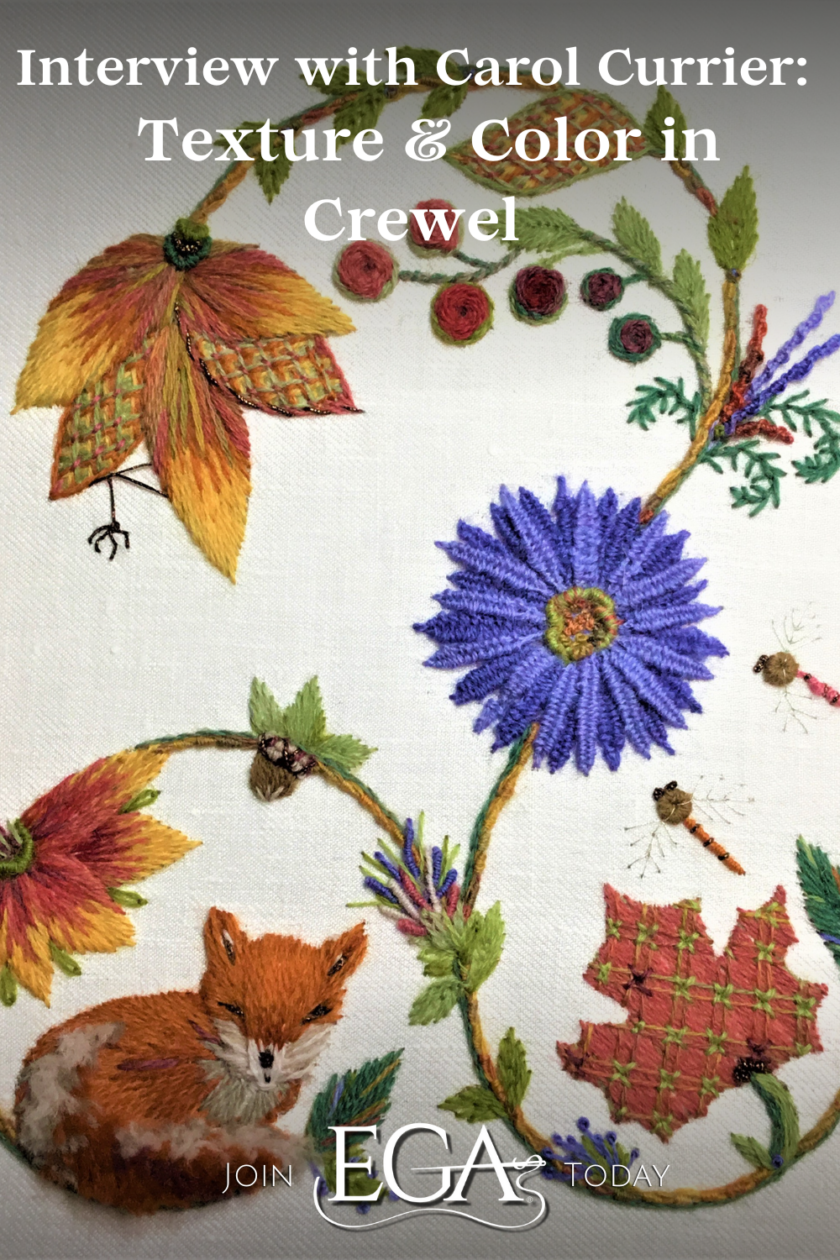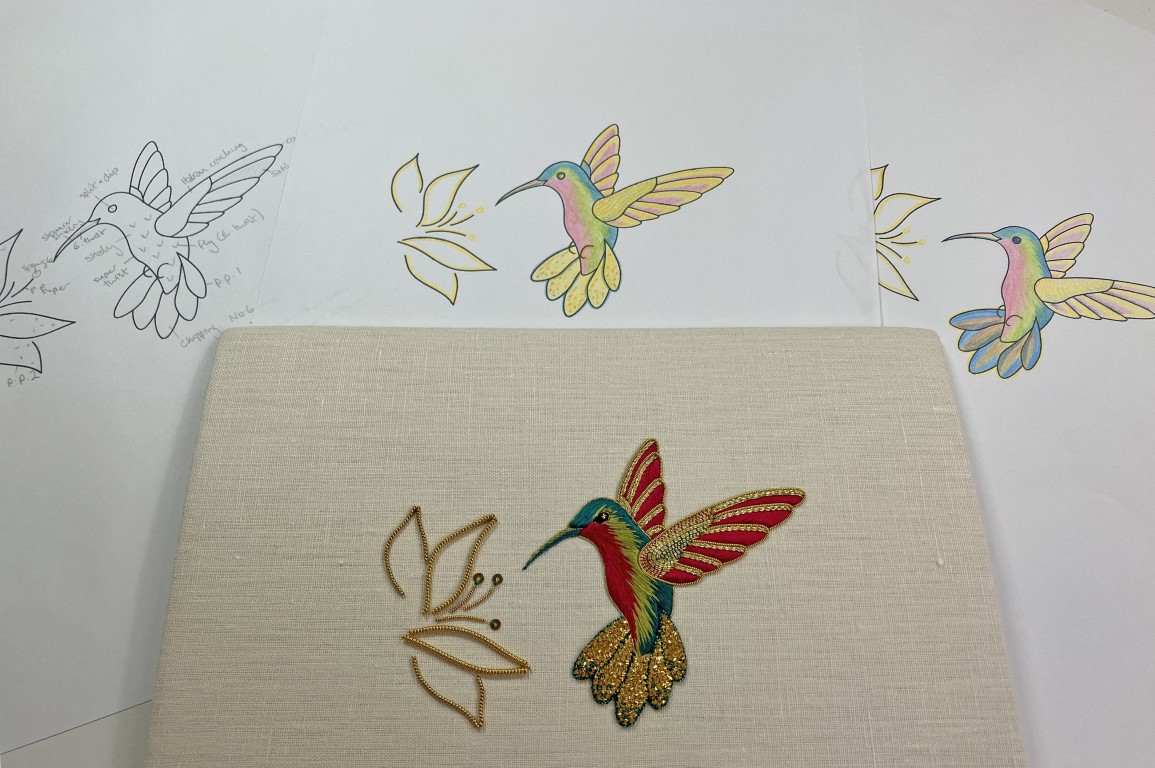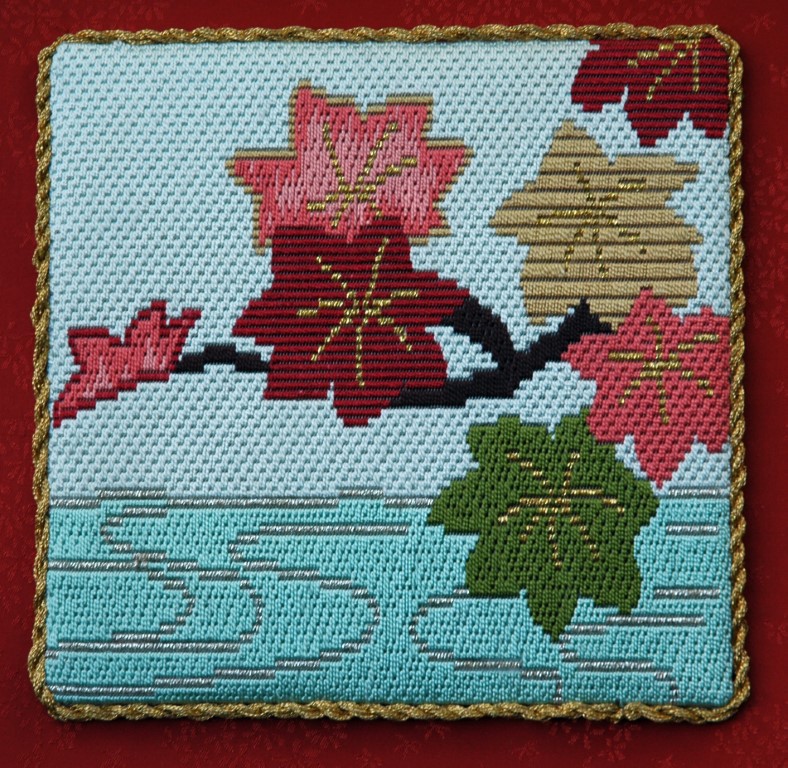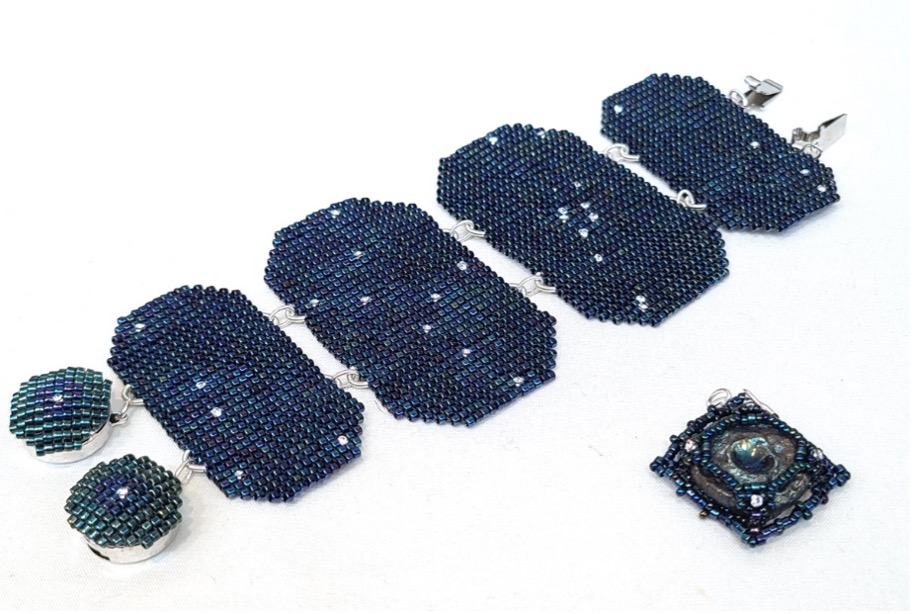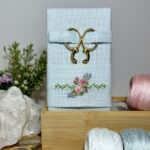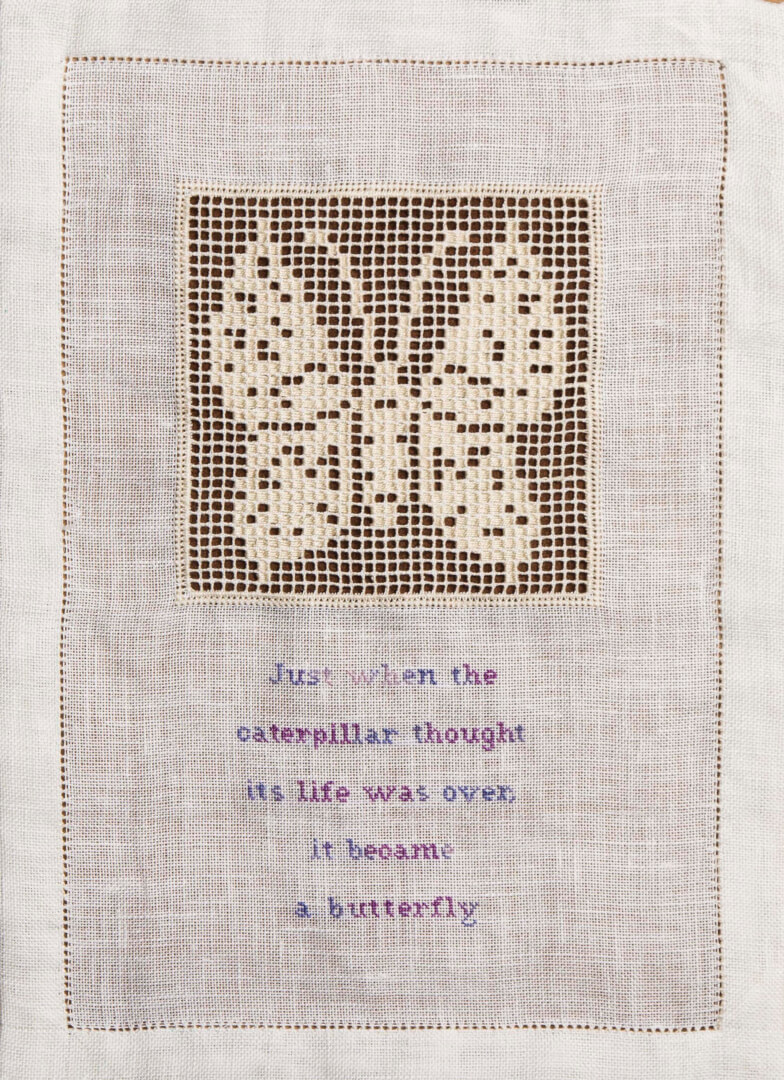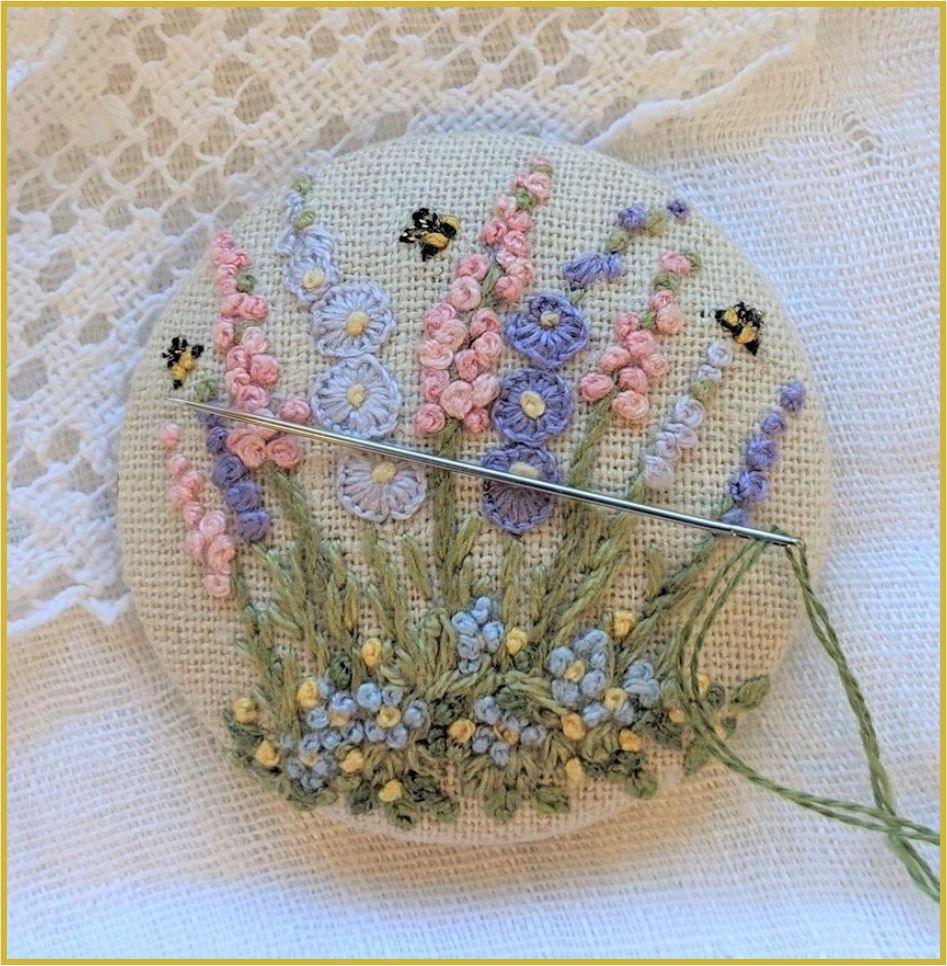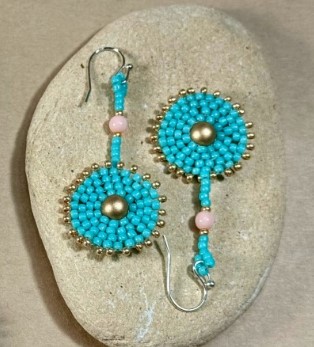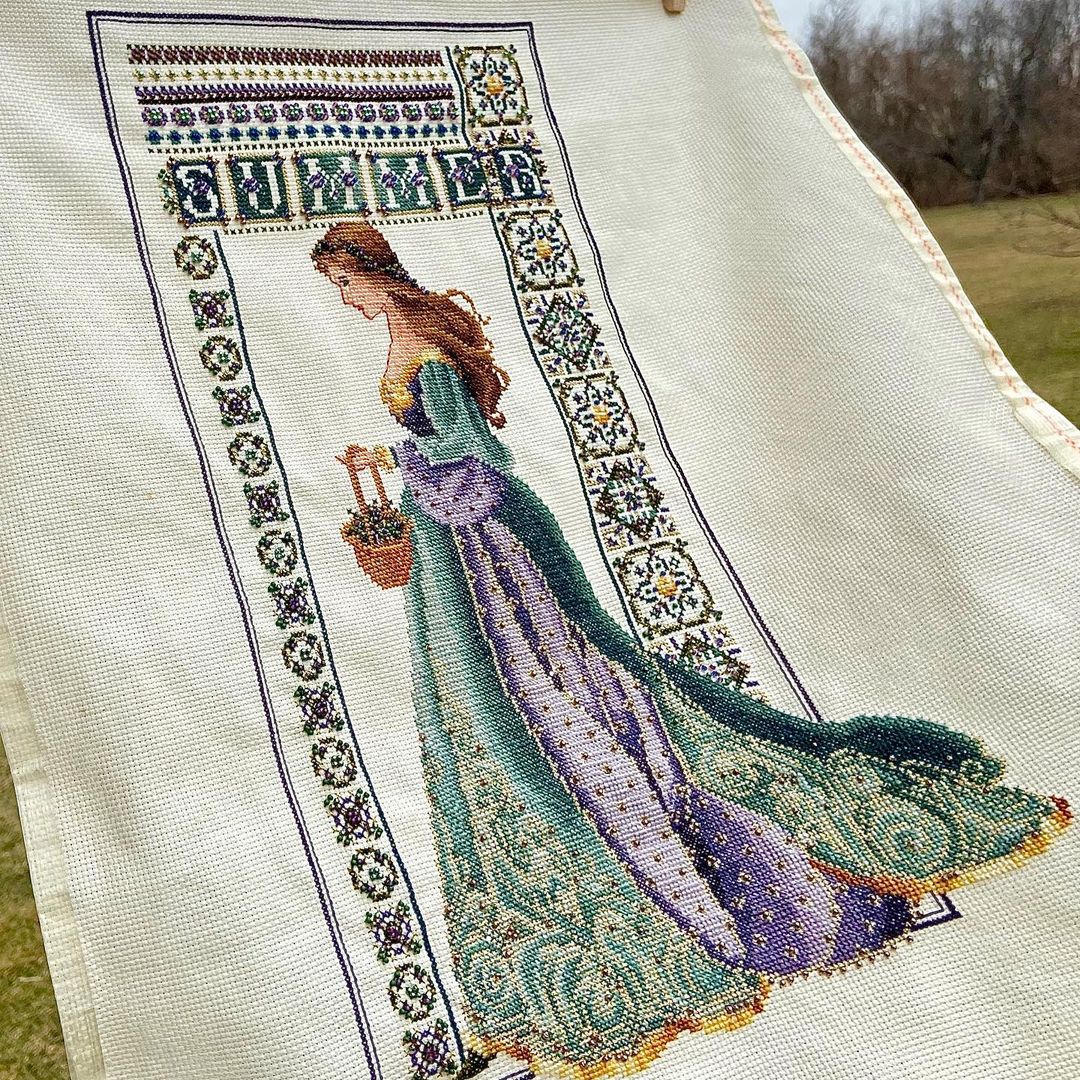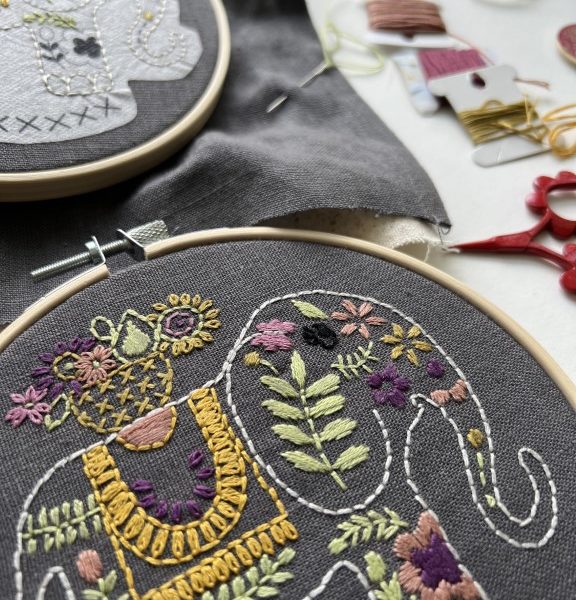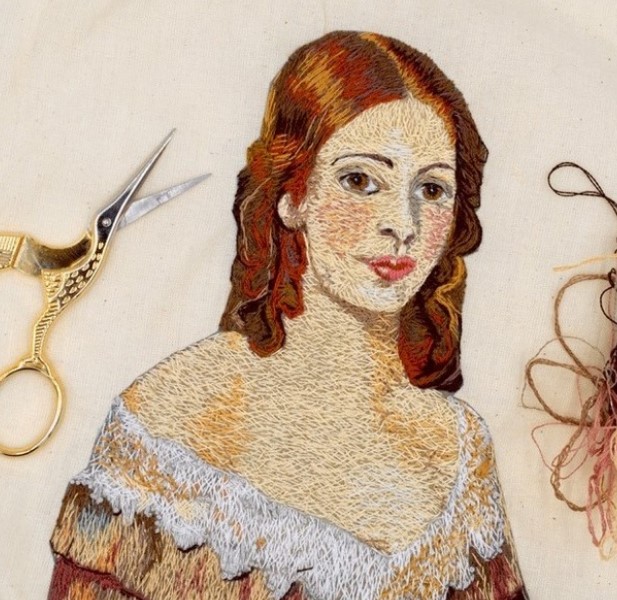Carol Currier has a long history with the Embroiderers’ Guild of America. Carol served on the national board of EGA for eight years, including as national President from 2007-2009. She is also the current EGA Chair of the Master Craftsman program in crewel embroidery and has four classes available through EGA’s many educational programs: Trio, Exploring Jacobean Crewel Embroidery, Avondale, and Boca Blossoms. Her love for embroidery is expansive. She is not only certified by the National Academy of Needlearts (NAN) as a surface embroidery teacher; she has also studied counted cross-stitch, Japanese embroidery, stumpwork, whitework, blackwork, and more. Her continuous studies in the embroidery medium allow her to cross-pollinate techniques, creating unique designs that borrow from multiple sources. We were delighted to sit down with Carol to learn more about her history with embroidery and discover where her future design work might lead.
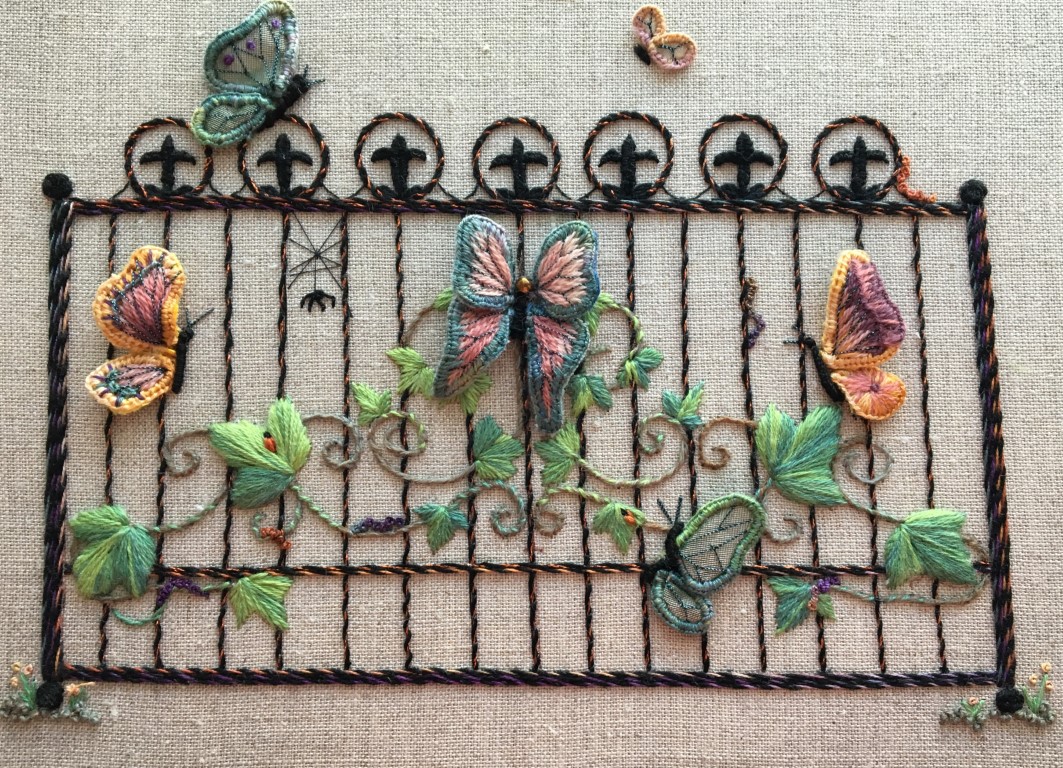
Where did your love of embroidery begin?
I was 8 or 9, when my best friend’s grandmother came to visit her for the summer. That lovely lady sat with us very patiently for many afternoons, teaching us the basics of embroidery. My allowance was quickly spent every week at Woolworths buying floss and preprinted patterns. In my teen years, I was drawn to counted cross-stitch and knitting. My parents bought me a sewing machine when I was 12 and I made most of my clothes, adding smocking when I had three daughters in my twenties. In my mid-twenties, Erica Wilson came to PBS, and I began to realize how many more techniques were out there in the world.
In my early thirties, my local needlepoint teacher encouraged me to attend Elsa Williams School, where another world opened to me. My father said he had never heard me so excited about anything! I was able to attend for two weeks a year and learn many different techniques from amazing teachers, including Elsa, Muriel Baker, Judy Way, Peg Lunt, Jody Adams, and many others. An amazing experience (my mother took the girls for those weeks and eventually went with me for a week with Elsa).
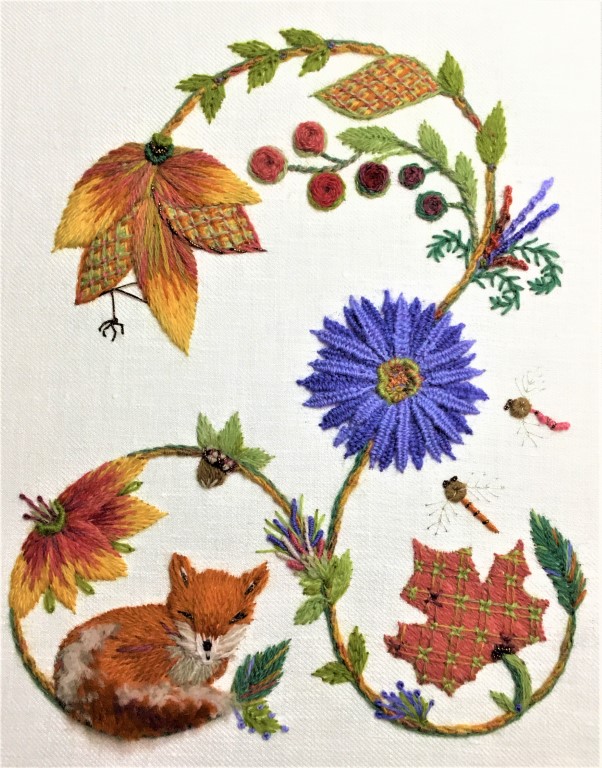
I went to an exhibit presented by the Connecticut River Chapter of EGA, and I found my home! That was about 50 years ago, and as we moved a lot, EGA became my home base. The first thing I did, every time I knew we were moving, was to find my next chapter. I was never without an EGA Chapter (or multiple chapters). I began teaching locally in the Ridgewood, NJ, Community School.
I was certified in surface embroidery by the National Academy of NeedleArts in the late 90’s.
What drew you to the crewel embroidery technique?
I love the softness of crewel wool and the ease of the color flow in shading. I started with Elsa Williams wool in my first class and went on to other types, such as Appleton and Fine D’Aubusson. I find Appleton the easiest for beginners in shading, especially with the large color range.
Short answer: texture and color.
I have also studied Japanese Embroidery, Counted Cross Stitch, Stumpwork, White Work, Black Work, and Needlepoint. I do a lot of needlepoint—I love the variety of threads. At the end of the day, I always return to crewel.
Recently, I took a class in surface embroidery with Hazel Blomkamp and experimented with beads, Heathway crewel wool, and metallics (photo below). I didn’t use her design, but translated her techniques into another design using crewel instead of cotton. It was so much fun to experiment.
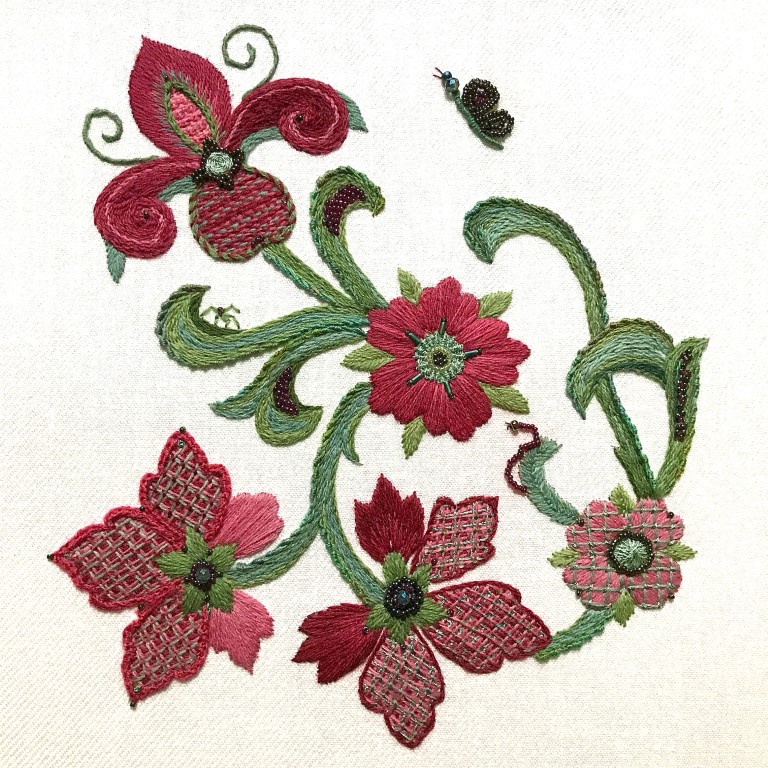
Do you have a favorite embroidery design? Why is it your favorite?
My favorite is usually the piece I’m working on. I just purchased the book A Garden of Curiosities by E.C. Lewis. containing line drawings of “Renaissance Inspired Designs for Contemporary Crafting.” I am in love! So many designs, so little time!
However, one of my early stumpwork pieces that I love is Eve in the Garden of Eden.
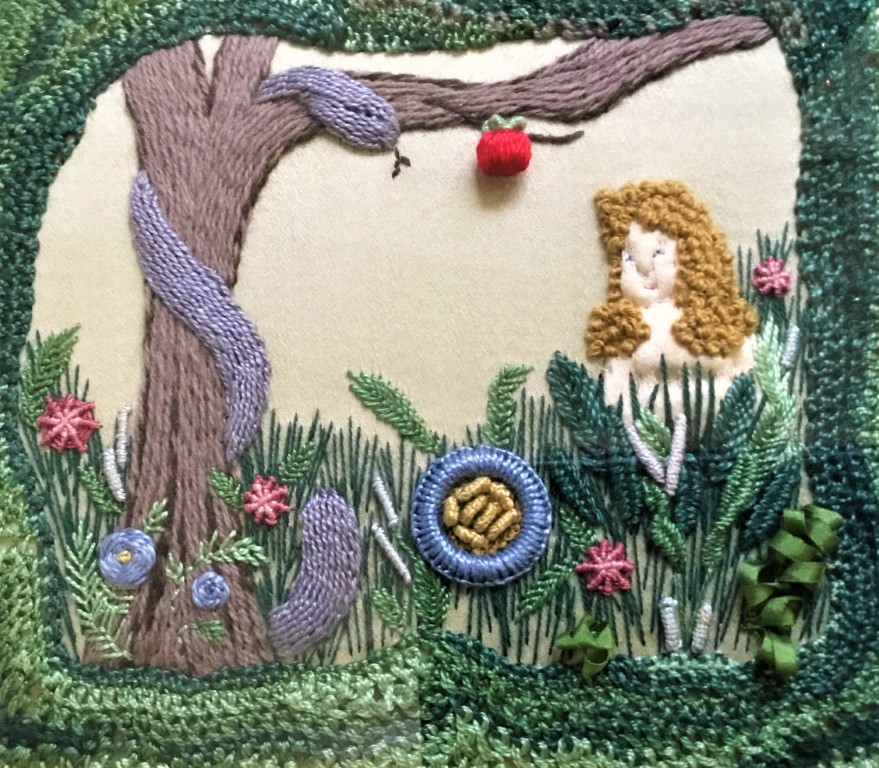
I also really like my Crewel Tree of Life – Warwicks Garden:
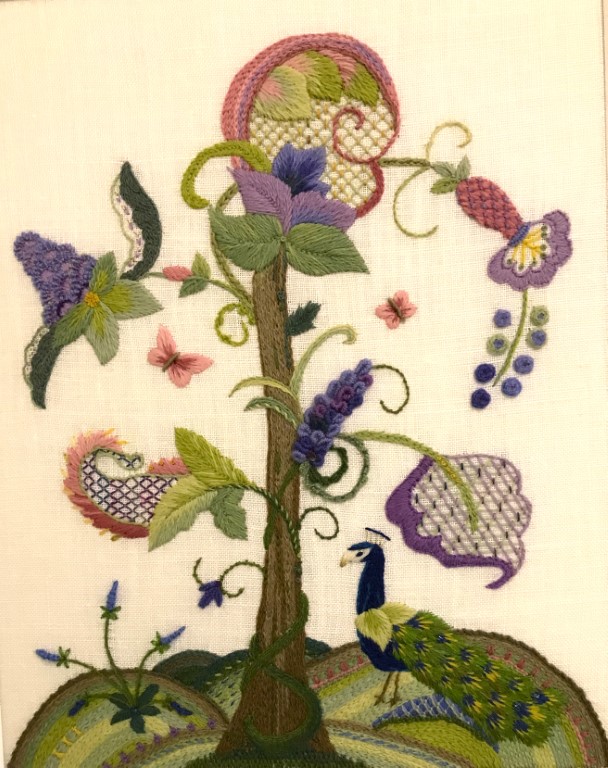
Do you have any embroidery tools you can’t live without?
My C Clamps so I can stitch with both hands.
You serve as the EGA Chair of the Master Craftsman program in crewel embroidery. What should interested stitchers know before undertaking this program?
Candidates should already possess expertise in Crewel. It is not a teaching course. Stitchers should take as many courses as possible with evaluations from their teachers to make sure they have the necessary skills to be a Master Craftman.
It is always sad to see a candidate fail to pass.
Some steps require designing skills and perfection in stitching your own design.
We try our best not to discourage anyone. Our job is to acknowledge excellence in stitching.
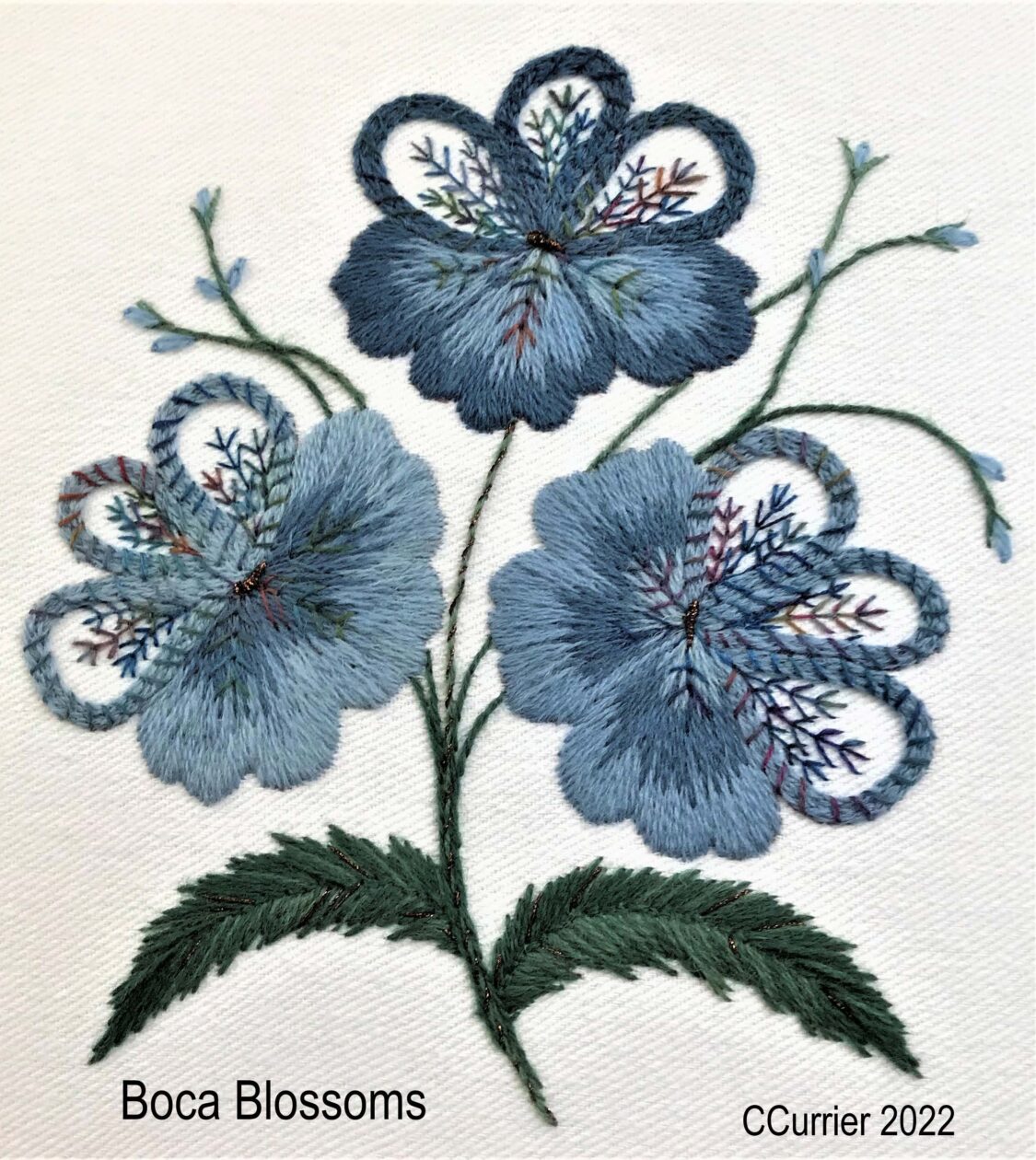
You currently offer several courses through EGA: Trio, Exploring Jacobean Crewel Embroidery, Avondale, and Boca Blossoms. If I were a beginner embroiderer interested in learning crewel embroidery, in what order should I take your classes? What specific techniques do each of these classes explore?
Boca Blossoms is a basic beginner class with an emphasis on shading.
Avondale is for the advanced beginner—but it will be retiring soon.
Trio is for the adventurous beginner who wants to create basic, individual designs with a little help from a friend. It contains stitched elements for mixing and matching.
Judy Jeroy has Technique Basics: An Introduction To Crewel And Surface Embroidery available for members in the Member Publications page. The site has many resources for the member who likes to explore.
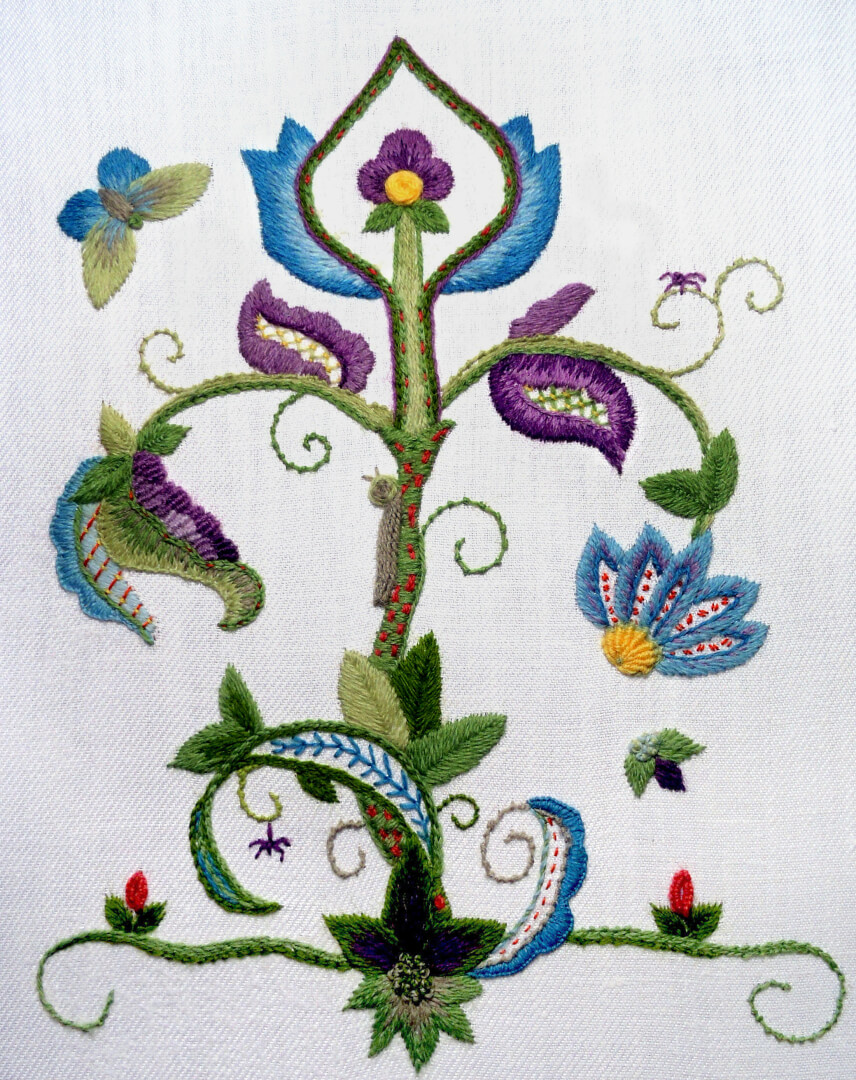
Do you have a daily/weekly/monthly practice that you’d recommend to other embroiderers interested in honing their craft?
Daily: Prioritize my work. I take a day to play sometimes, but I try to do serious stitching or designing every day.
Straighten up my work table—I am messy.
Review the schedule for the day—I am taking an online teaching course and need to remember to sign in at the right time.
In the evening, I browse one of my embroidery books (I have many and I love the inspirational, calming effect) and stitch on whatever I wish.
Weekly: At the end of the week, I evaluate what was accomplished for the week and list priorities for the following week. I make a plan, which does not always fall into place.
Monthly: Reevaluate the projects on which I spend the most time. Are the projects I spend the most time on the ones that advance my skills as an artist and a teacher? Evaluate my goals.
Do you have a favorite piece of embroidery advice?
Time is a gift. If a project is not making you happy, move on to something else. It may seem wasteful to leave a project incomplete, but enjoy what you learned from it and move on.
What do you hope embroiderers take from your courses on crewel embroidery?
A love of color, texture, and inspiration and confidence to stitch more advanced designs.
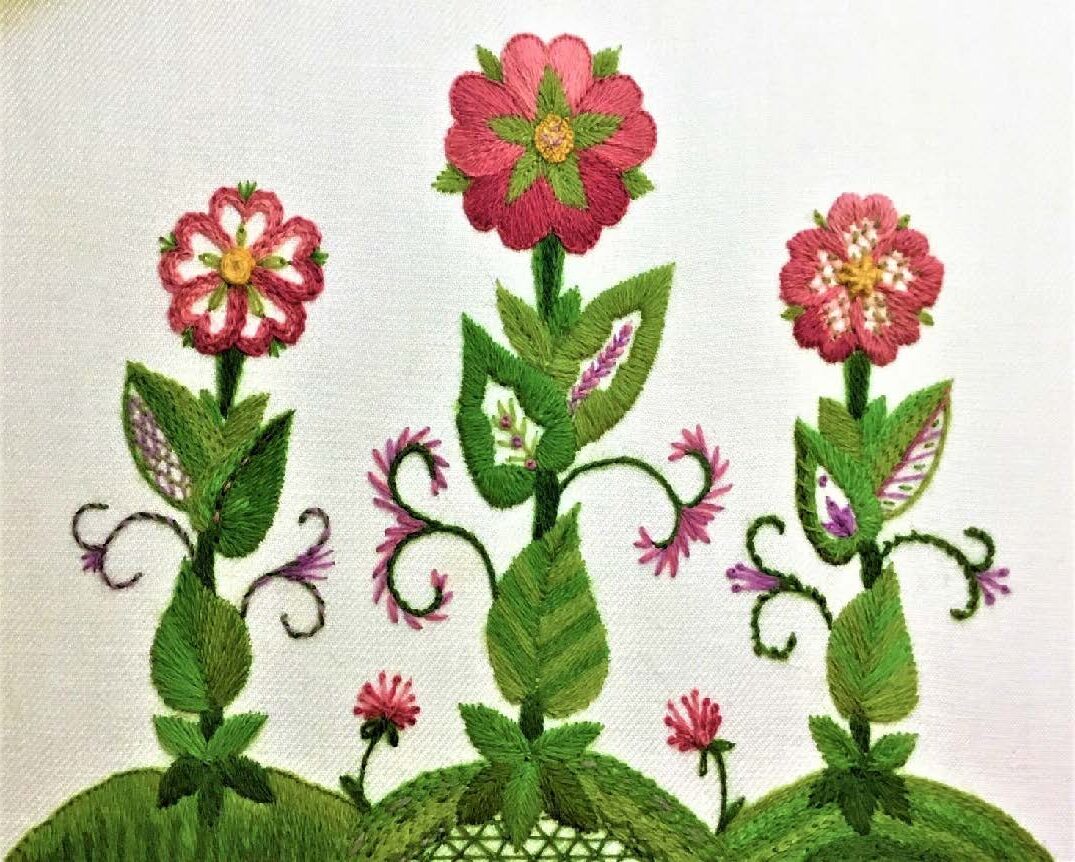
Where can interested needleworkers discover more of your work and upcoming projects and events? (website link, social media link, etc)
I am still working on a website. And I hope to have more ICCs and GCCs on the EGA site. I am working on virtual teaching classes and being more adventurous!
